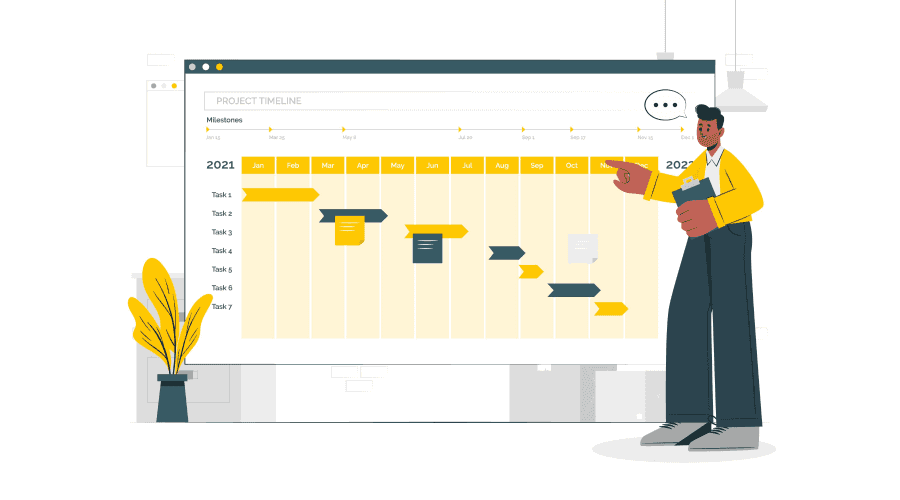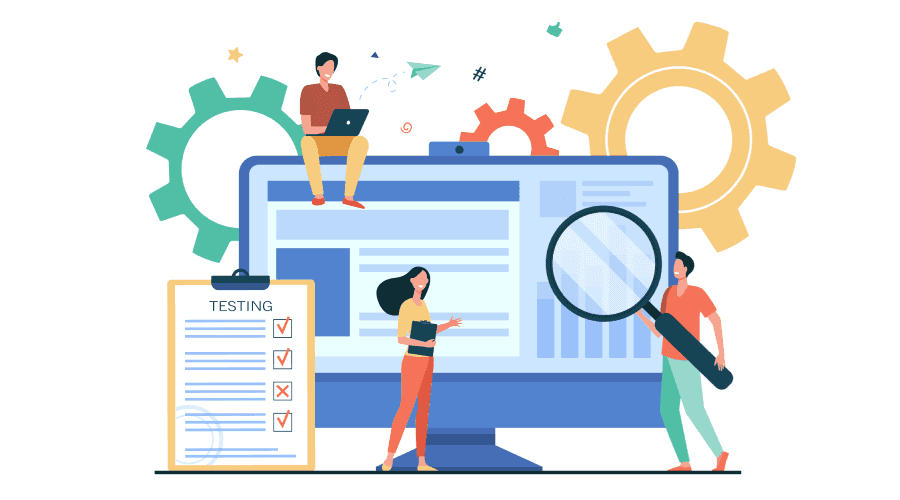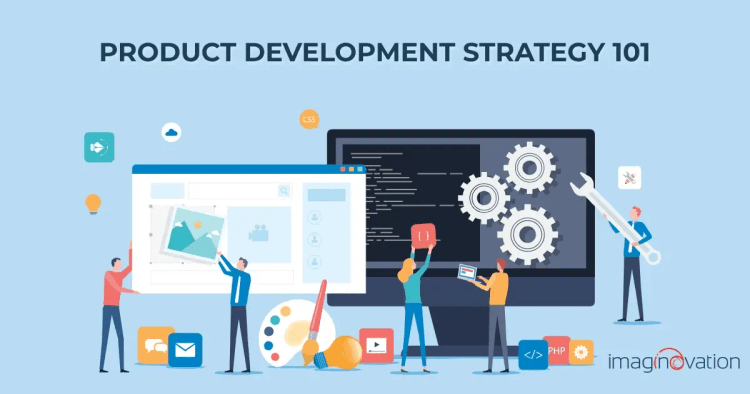Launching a new product is an exhilarating yet daunting endeavor. Whether it's physical or digital, the journey of product development has its complexities.
However, having a well-defined product development strategy can simplify and solidify the process.
This blog post serves as an indispensable guide for entrepreneurs, product managers, or anyone looking to launch a successful product.
It shares essential insights on defining your product vision and creating a roadmap aligned with your business goals.
So, let’s go!
What is a Product Development Strategy?
Every new as well as rebranded product needs a strategy.
However, the process of building a product strategy begins with a vision for your product. Its main aim is to beat the unpredictable and competitive market forces so that your product succeeds. That's why you must build a good understanding of the market you'll be targeting.
In short, product strategy is like making a plan for your product at the very outset. You decide how and what you want with the new product.
In fact, even before the ‘what’ and ‘how,’ you must first figure out why you're making the product.
A product development strategy refers to the techniques and initiatives used to introduce new products to the market or modify/recreate/rebrand existing ones to cultivate new business opportunities.
Product development involves multiple stages, from conceiving an idea to launching the final product for customers. A well-crafted strategy at each step is essential to achieve success and drive revenue growth for your business.
Besides, a well-designed product development journey helps ensure that the products you build solve problems for people, are easy to use, and, ideally, delight the end user.
Understanding Product Vision
Every successful product starts with a clear and compellingproduct vision.
Product managers are responsible for coming up with a vision that outlines how your product will bring positive changes to your customers' lives.
Let's first understand what it means.
You can think of a product vision as a dream or a big idea for your product - Just like a really inspiring goal.
Imagine you're the CEO of a company, and you have a dream of how your business will make the world a better place for your customers in the future. But that's your company vision.
As a product manager, you need to come up with a vision specifically for your product. This vision is about how your product will bring positive changes to your customers' lives.
So, instead of answering, "In the next few years, how will my company make the world a better place for customers?" your product vision answers the question, "In the next few years, how will my product make the world a better place for customers?"
To further understand the concept of product vision, think about a time when you were lost on a road trip. While it can be thrilling to wander and stumble upon unexpected surprises, wandering aimlessly is not sustainable if you have a specific destination in mind.
A product vision, therefore, serves as your destination. It provides a clear direction for your product development journey.
Here are the elements of a strong product vision.

1. Identifying Customer Needs and Problems to Solve.
To create a strong product vision, it is essential that you understand the needs and problems faced by the target customers.
You can do so by conducting market research and customer interviews. This can help you gain valuable insights into their pain points and find opportunities for innovation.
2. Defining Target Users and Key Benefits.
A strong product vision defines target users and the value it delivers.
By understanding their specific requirements, the product can effectively address their needs. Articulating key benefits helps focus on building competitive features that resonate with users.
3. Articulating a Compelling Vision Statement.
With an impactful vision statement, you can communicate your product's purpose, goals, and desired outcomes.
Try writing a well-crafted vision statement that inspires your team while providing a clear direction for product development.
4. The future.
This aspect should cover how you envision your customers thinking about your product in the future. What kind of legacy should this product aim for in the future?
Also Read: An Executive's Guide to Agile Product Development
Crafting a Product Development Roadmap
Once you begin your product development journey, it is essential that you stay on the right track. And for that, you need a well-crafted product development roadmap.
This roadmap is like a treasure map that guides you through the twists and turns of development, helping you navigate challenges, make informed decisions, and ultimately deliver a remarkable product.
Here’s how you can design a fool-proof product development roadmap.
1. Define your product vision
One common mistake that leads to failure in product roadmap is a lack of a clear purpose. It's important to understand that the "why" behind your product differs from the "what."
While it's good to have a clear idea of the features you want to build and your target audience, you need to grasp the purpose behind your product to avoid challenges that might jeopardize its success.
To address this issue, begin by articulating your long-term vision for the product. This vision should align closely with your company's goals. It must also outline the objectives you aim to achieve with your product, focusing on the value it will provide to customers and how it addresses their needs and pain points.
To ensure consistency in product delivery, it's crucial to establish shared goals and a common product vision.
To define the purpose of your product, consider asking yourself the following questions:
- Why do you want to build this product?
- What benefits does this product bring?
- How will the development of this product specifically benefit the users?
2. Set clear and measurable objectives

The second step is to establish specific and measurable objectives for your roadmap. These objectives should be aligned with your product vision and contribute to your overall business goals.
Ensure that your objectives are achievable, measurable, and time-bound. This allows you to track progress and measure success.
So, when setting objectives for your team, consider them as a mission statement with a specific timeframe. These objectives will inspire and guide your team towards a clear goal, allowing you to define the necessary steps to be taken within that timeframe.
In addition, you must quantify your objectives by including key results. They provide specific and measurable goals, helping you determine whether or not you have achieved them.
Let's take a simple example here.
The objective could be - To improve the User Experience of your website. You can quantify this by adding key results such as:
- Key Result #1: Reduce new user signup time by 30%.
- Key Result #2: Increase the task success rate from 60% to 80%.
- Key Result #3: Raise the System Usability scale from 70 to 90.
3. Assign resources and budget
Assigning budget and resources in a product development roadmap is essential to planning and executing a successful project.
The timing for allocating budget and resources can vary depending on the organization, project complexity, and the specific requirements of the product being developed.
Here’s how you can do it. -
- Define objectives and estimate initial budget and resource needs.
- Refine budget based on market research and concept development.
- Allocate budget and resources precisely based on the product strategy and roadmap.
- Create detailed plans, assign resources to tasks, and establish an accurate budget.
Additional tips -
- Actively manage resources and budget during development, making adjustments as needed.
- Allocate resources for quality assurance and testing to ensure product quality.
- Allocate the budget for effective marketing and product launch activities.
4. Build the team based on a clear understanding
It is now time to build your ideal team. Remember, the best roadmaps involve cross-functional teams, not just software developers.
This team should include key players who can help determine the best features for your product and target audience.
There should be at least four primary elements of this team.
- Leadership: Focus on simplicity and avoid technical jargon. Ensure that the product aligns with the company's primary goals and vision.
- Tech team: Provide clear answers to "what," "why," and "when" so they can define a timeline and understand expectations.
- Marketing: Work with them to determine the best ways to reach your target audience and provide a clear vision for their marketing campaigns.
- Sales: Ensure they understand the "why" behind the product and how to sell it based on its unique features.
By involving a cross-functional team and communicating clearly with them, you'll increase your chances of building a successful product.
5. Prioritize features
This step may take more time than other steps, as it involves thorough research and consideration of various factors for product success. You'll need to answer important questions such as:
- What is the current market situation?
- Why would your product work?
- What are your competitors doing?
- Are there any new or similar products in the market?
By answering these questions, you can start identifying and prioritizing key features for your product.
Do not overwhelm your product with too many features. Instead, focus on a few powerful features that set you apart from the competition.
Prioritizing the right features enhances your chances of standing out and delivering a successful product.
To determine the order of feature development, evaluate factors like potential impact, required effort, and necessary resources for each feature or initiative. Prioritize them based on customer needs, business objectives, and market demand.
Factors such as customer feedback, market trends, technical feasibility, and resource availability should all be considered.
Also Read: How SME's Can Leverage Emerging Technologies for Business Success
6. Define a timeline

Develop a timeline that outlines the sequence and duration of different development phases.
A timeline serves several important purposes:
- A timeline with a structured plan is needed to help teams manage their tasks and responsibilities effectively. It outlines when specific activities and milestones should be completed, which helps in allocating resources and tracking progress.
- Having a timeline allows you to allocate resources, such as team members, budget, and technology, in a coordinated manner. It ensures that resources are available when needed, preventing bottlenecks and delays.
- Timelines also help prioritize tasks and activities. Not all features or tasks can be done simultaneously, so a timeline helps determine the order in which they should be tackled based on their importance and dependencies.
- Timelines also help identify potential risks and bottlenecks early in the development process. If a task takes longer than anticipated, it can be addressed promptly to minimize its impact on the project schedule.
- Timelines are essential for setting realistic and achievable deadlines. They help set clear goals and objectives, which are critical for maintaining motivation and focus within the team.
7. Design
The design and prototyping step in the product development journey is yet another critical phase. It focuses on creating a user-friendly and visually appealing product.
This phase involves multiple steps, including developing wireframes, mock-ups, and prototypes and iterating on the design based on user feedback and usability testing.
- Wireframes - Wireframes are simple, low-fidelity visual representations of the product's layout and structure. They serve as a blueprint for the user interface (UI) and help define the placement of elements such as buttons, menus, and content. They do not include detailed design elements.
- Mock-ups - Mock-ups are higher-fidelity representations of the product's UI. They incorporate design elements such as colors, typography, and imagery. Mock-ups provide a more realistic preview of what the final product will look like.
- Prototypes - Prototypes are interactive, functional representations of the product. They allow users to interact with the product's interface, providing a more immersive experience. They are essential for usability testing.
Once a prototype is available, gathering user feedback through usability testing and user interviews becomes crucial. Users' interactions with the prototype can reveal insights into what works well and what needs improvement.
8. Testing, beta release, final product release

Avoiding this step in product development has led to product failures in the past.
You might create a product you believe will be popular, but what if the customers do not see any value in it?
This step aims to identify which features in the prototype work and which do not. We are sure you want to create something customers are willing to pay for and demand.
Once the prototype is ready, you can begin testing and building the final product. This testing phase involves creating a simulation of your product with the integrated key features.
After receiving user feedback, you can take your product back, make improvements, and test it again.
And you are ready for the beta release. It involves conducting the final round of testing before making the product available to a wider audience.
During the beta release, you provide your software or application to a large group of users to try under real conditions. You can even publish your applications in app stores, indicating that it is in the beta release phase.
After the beta release, you can gather data from users and craft the final version of your product. Various team areas, including engineering, customer support, sales, and marketing, will collaborate on final release strategies to ensure the product's success.
Also Read: The Role of UX in Product Development: In-Depth Overview
Benefits of a Clear Development Strategy
Developing a clear product development strategy offers multiple advantages for your business.
First, it provides a roadmap for your product's success. How?
By defining clear goals and objectives. This clarity helps guide decision-making throughout development, ensuring your efforts are focused and aligned with the overall product vision.
Moreover, a well-crafted development strategy enables you to identify and prioritize market opportunities. By conducting thorough market research and understanding customer needs, you can have a product that addresses those needs and stands out among the competition.
In addition, with a clear product development strategy, you can do better resource and budget allocation. By outlining the necessary steps, timeframes, and required resources, you can optimize the allocation of budget and manpower, leading to increased efficiency and reduced costs.
A well-designed strategy also fosters collaboration and alignment among different teams and stakeholders involved in the development process. When everyone is on the same page, it enhances communication, coordination, and decision-making.
Ultimately, a clear product development strategy increases the likelihood of success by keeping the development process on track. There is minimal risk of going off-course or wasting resources on unnecessary features, thus ensuring that the final product meets customer expectations and delivers value.
Common Pitfalls to Avoid
When you build a clear product development strategy, there are some pitfalls to avoid, particularly in defining the product vision and creating a roadmap. Here are some common mistakes and errors to steer clear of:
1. Lack of a clear product vision
A common mistake is not having a well-defined product vision. Without a clear vision, your team may lack focus and direction, leading to confusion and inefficiencies. Avoid this and clearly articulate the product vision, outlining the value proposition, target market, and long-term goals.
2. Not involving key stakeholders in defining the product vision
Another mistake to avoid is leaving out key stakeholders when defining the product vision. Customers, executives, marketing, and development teams all have valuable insights. Involving them creates a more complete vision, while excluding them leads to a limited perspective.
3. Failing to conduct market research
Make sure to complete market research when shaping your product vision. Understanding the market, customer needs, and competition is vital. Invest in comprehensive analysis to uncover trends, customer pain points, and opportunities, and use this information to refine your product vision.
4. Overcommitting or underestimating timelines
Mistakes often happen when you misjudge project timelines. Unrealistic deadlines lead to rushed work, while overly long timelines waste resources. To avoid this, assess requirements and dependencies and involve the development team in setting realistic deadlines. Keep reviewing and adjusting the timeline based on feedback and progress.
5. Ignoring user feedback and market validation
Not gathering user feedback can hurt the product development strategy. It can result in building a product that doesn't work for the target audience. To fix this, involve users throughout the development process, gather feedback, conduct user tests, and iterate based on insights.
6. Being too rigid with the roadmap
A rigid roadmap can make it hard to adapt to changes and may not keep up with customer needs or new insights. To avoid this, create a flexible roadmap that balances long-term goals with short-term adjustments. Regularly review and update the roadmap to include new information and focus on the most important things.
Develop a Powerful Product with Imaginovation
At Imaginovation, we build product visions that are user-centric. That means we help you stay focused on the benefits to your end user.
Choose Imaginovation as your partner in transforming your vision into reality and building a powerful product.
Our experienced team will help you create a winning product strategy that totally aligns with market demands and customer needs. We guide you through defining your vision, conducting market research, and validating assumptions through user feedback.
Our flexible roadmap ensures you develop a high-impact product.
Contact us today.
Ready to build an app, but not sure where to start?
We've got you covered. Click the button below to get started.





